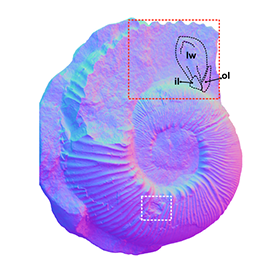DISCOVERY OF AMMONOID JAW APPARATUS AND ASSOCIATED FEATURES USING REFLECTANCE TRANSFORMATION IMAGING (RTI)
DOI:
https://doi.org/10.5710/PEAPA.28.12.2022.430Keywords:
Ammonoidea, Maorites, seymourianus, Antarctica, Buccal, Apparatus, Aptychus, Marambio, Island, López de Bertodano Fm.Abstract
We report on remains of the buccal apparatus and possible associated structures for the Late Cretaceous ammonite Maorites seymourianus from the López de Bertodano Formation (Antarctic Peninsula). This is the first description of these structures for the family Kossmaticeratidae. Further, we discuss the most likely taphonomic processes taking place that allowed this exceptional preservation. Reflectance Transformation Imaging (RTI) technique was employed in this work to better document the faint structures. We briefly provide a review of this method and its potential importance for paleontological studies because it seems that this powerful technique has been largely overlooked by paleontologists.
References
Barlow, L.A., Pittman, M., Butcher, A., Martill, D.M., and Kaye, T.G. (2021). Laser-stimulated fluorescence reveals unseen details in fossils from the Upper Jurassic Solnhofen Limestones. Royal Society Open Science, 8:1-13. https://doi.org/10.1098/rsos.211601
Béthoux, O., Llamosi, A., and Toussaint, S. (2016). Reinvestigation of Protelytron permianum (Insecta; Early Permian; USA) as an example for applying reflectance transformation imaging to insect imprint fossils. Fossil Record, 20(1):1-7. https://doi.org/10.5194/fr-20-1-2016
Blender Online Community (2022). Blender, a 3D Modelling and Rendering Package. https://www.blender.org/download/releases/2-81/
Boute, R., Hupkes, M., Kollaard, N., Wouda, S., Seymour, K., and ten Wolde, L. (2018). Revisiting Reflectance Transformation Imaging (RTI): A Tool for Monitoring and Evaluating Conservation Treatments. IOP Conference Series: Materials Science and Engineering, 364:012060. https://doi.org/10.1088/1757-899x/364/1/012060
Carlotto, M. (1988). Digital imagery analysis of unusual Martian surface features. Applied optics, 27:1926-33. https://doi.org/10.1364/AO.27.001926
Cherns, L., Spencer, A.R.T., Rahman, I.A., Garwood, R.J., Reedman, C., Burca, G., Turner, M.J., Hollingworth, N.T.J., and Hilton, J. (2021). Correlative tomography of an exceptionally preserved Jurassic ammonite implies hyponome-propelled swimming. Geology. https://doi.org/10.1130/G49551.1
Clements, T., Colleary, C., De Baets, K., and Vinther, J. (2017). Buoyancy mechanisms limit preservation of coleoid cephalopod soft tissues in Mesozoic Lagerstätten. Palaeontology, 60:1–14. 10.1111/pala.12267
Cunningham, J.A., Rahman, I.A., Lautenschlager, S., Rayfield, E.J., and Donoghue, P.C.J. (2014). A virtual world of paleontology. Trends in Ecology & Evolution, 29(6):347-357. https://doi.org/10.1016/j.tree.2014.04.004
Feldmann, R. (1989). Whitening fossils for photographic purposes. The Paleontological Society Special Publications, 4:342-346. https://doi.org/10.1017/S2475262200005323
Giovannetti, G., Guerrini, A., and Salvadori, P.A. (2016). Magnetic resonance spectroscopy and imaging for the study of fossils. Magn Reson Imaging, 34(6):730-742. https://doi.org/10.1016/j.mri.2016.03.010
Hammer, O. and Spocova, J. (2013). Virtual whitening of fossils using polynomial texture mapping. Palaeontologia Electronica, 16. https://doi.org/10.26879/384
Hammer, O., Bengtson, S., Malzbender, T., and Gelb, D. (2002). Imaging fossils using reflectance transformation and interactive manipulation of virtual light sources. Palaeontologia Electronica, 5:1-9. http://palaeo-electronica.org/paleo/2002_1/fossil/issue1_02.htm
Hoffmann, R., Schultz, J., Schellhorn, R., Rybacki, E., Keupp, H., R Gerden, S., Lemanis, R., and Zachow, S. (2013). Non-invasive imaging methods applied to neo-and paleontological cephalopod research. 10:18803-18851. https://doi.org/10.5194/bgd-10-18803-2013
Hoffmann, R., Schultz, J.A., Schellhorn, R., Rybacki, E., Keupp, H., Gerden, S.R., Lemanis, R., and Zachow, S. (2014). Non-invasive imaging methods applied to neo- and paleo-ontological cephalopod research. Biogeosciences, 11(10):2721-2739. https://doi.org/10.5194/bg-11-2721-2014
Kilian, W. and Reboul, P. (1909). Les Cephalopodes neocretacées des Iles Seymour et Snow ill. Wissenschaftliche Ergebnisse der Schwedischen Südpolar-Expedition 1901-1903, Stockholm, 3:1-75.
Klug, C., Landman, N.H., Fuchs, D., Mapes, R.H., Pohle, A., Guériau, P., Reguer, S., and Hoffmann, R. (2019). Anatomy and evolution of the first Coleoidea in the Carboniferous. Communications Biology, 2:280. https://doi.org/10.1038/s42003-019-0523-2
Kozub, D., Shapoval, J., Yatsenko, S., Starikh, V., and Dobarskyi, A. (2022). Helicon Focus 8.0.4. Helicon Soft Ltd., 2000. https://www.heliconsoft.com/heliconsoft-products/helicon-focus/
Kröger, B., Vinther, J., and Fuchs, D. (2011). Cephalopod origin and evolution: A congruent picture emerging from fossils, development and molecules: Extant cephalopods are younger than previously realised and were under major selection to become agile, shell-less predators. Bioessays, 33(8):602-13. 10.1002/bies.201100001
Kruta, I., Bardin, J., Smith, C.P.A., Tafforeau, P., and Landman, N.H. (2020). Enigmatic hook-like structures in Cretaceous ammonites (Scaphitidae). 63:301-312. https://doi.org/10.1111/pala.12457
Linneaus, C.v. (1758). Systema naturæ: per regna tria naturaæ, secundum classes, ordines, genera, species, cum characteribus, differentiis, synonymis, locis. , 1. Impensis Direct. Laurentii Salvii, Holmiæ (Estocolmo).
Macellari, C.E. (1986). Late Campanian–Maastrichtian Ammonite Fauna from Seymour Island (Antarctic Peninsula). Journal of Paleontology, 60:1-55. https://doi.org/10.1017/S0022336000060765
Macellari, C.E. (1988). Stratigraphy, sedimentology, and paleoecology of Upper Cretaceous/Paleocene shelf-deltaic sediments of Seymour Island, Geology and Paleontology of Seymour Island Antarctic Peninsula (pp. 0). Geological Society of America. https://doi.org/10.1130/MEM169-p25
Marshall, J.D. and Pirrie, D. (2013). Carbonate concretions—explained. 29(2):53-62. https://doi.org/10.1111/gto.12002
Microsoft-Corporation (2015). Image Composite Editor 2.0.3.0. Microsoft Research ICE. https://www.microsoft.com/en-us/research/product/computational-photography-applications/image-composite-editor/
Min, J., Jeong, S., Park, K., Choi, Y., Lee, D., Ahn, J., Har, D., and Ahn, S. (2021). Reflectance transformation imaging for documenting changes through treatment of Joseon dynasty coins. Heritage Science, 9(1):105. https://doi.org/10.1186/s40494-021-00584-3
Morita, M.M., Novoa, F.D., and Bilmes, G.M. (2019). Reflectance transformation imaging. First applications in cultural heritage in Argentina. Journal of Archaeological Science: Reports, 26:101899. https://doi.org/10.1016/j.jasrep.2019.101899
Morón-Alfonso, D.A. (2019). Exploring the paleobiology of ammonoids (Cretaceous, Antarctica) using non-invasive imaging methods. Palaeontologia Electronica, 22.3.57:1-17. https://doi.org/10.26879/1007
Morón-Alfonso, D.A., Peterman, D., J., Cichowolski, M., Hoffmann, R., and Lemanis, R., E. (2020). Virtual 3D modeling of the ammonoid conch to study its hydrostatic properties. Acta Palaeontologica Polonica, 65:467-480. https://doi.org/10.4202/app.00776.2020
Nixon, M. and Young, J.Z. (2003). The brains and lives of cephalopods, 1. Oxford University Press, Oxford, UK.
Olivero, E.B. (2012). Sedimentary cycles, ammonite diversity and palaeoenvironmental changes in the Upper Cretaceous Marambio Group, Antarctica. Cretaceous Research, 34:348-366. https://doi.org/10.1016/j.cretres.2011.11.015
Palma, G., Corsini, M., Cignoni, P., Scopigno, R., and Mudge, M. (2010). Dynamic shading enhancement for reflectance transformation imaging. JOCCH, 3:6. https://doi.org/10.1145/1841317.1841321
Pan, Y., Hu, L., and Zhao, T. (2019). Applications of chemical imaging techniques in paleontology. National Science Review, 6:1-14. https://doi.org/10.1093/nsr/nwy107
Parry, L.A., Smithwick, F., Nordén, K.K., Saitta, E.T., Lozano-Fernandez, J., Tanner, A.R., Caron, J.-B., Edgecombe, G.D., Briggs, D.E.G., and Vinther, J. (2018). Soft-Bodied Fossils Are Not Simply Rotten Carcasses – Toward a Holistic Understanding of Exceptional Fossil Preservation. 40(1):1700167. https://doi.org/10.1002/bies.201700167
Pérez-Ramos, A. and Figueirido, B. (2020). Toward an “Ancient” Virtual World: Improvement Methods on X-ray CT Data Processing and Virtual Reconstruction of Fossil Skulls. 8:1-23. https://doi.org/10.3389/feart.2020.00345
Peterman, D., Mikami, T., and Inoue, S. (2020). The balancing act of Nipponites mirabilis (Nostoceratidae, Ammonoidea): Managing hydrostatics throughout a complex ontogeny. PLOS ONE, 15(8):e0235180. https://doi.org/10.1371/journal.pone.0235180
Peterman, D., Ciampaglio, C., Shell, R., and Yacobucci, M. (2019). Mode of life and hydrostatic stability of orthoconic ectocochleate cephalopods: Hydrodynamic analyses of restoring moments from 3D printed, neutrally buoyant models. Acta Palaeontologica Polonica, 64:441-460. https://doi.org/10.4202/app.00595.2019
Sasaki, T., Shigeno, S., and Tanabe, K. (2010). Anatomy of living Nautilus: Reevaluation of primitiveness and comparison with Coleoidea. In Tanabe, K., Shigeta, Y., Sasaki, T., and Hirano, H. (eds.), Cephalopods - Present and Past (pp. 35-66). Tokai University Press, Tokyo, Japan.
Scasso, R.A., Prámparo, M.B., Vellekoop, J., Franzosi, C., Castro, L.N., and Sinninghe Damsté, J.S. (2020). A high-resolution record of environmental changes from a Cretaceous-Paleogene section of Seymour Island, Antarctica. Palaeogeography, Palaeoclimatology, Palaeoecology, 555:109844. https://doi.org/10.1016/j.palaeo.2020.109844
Schoepfer, S.D., Tobin, T.S., Witts, J.D., and Newton, R.J. (2017). Intermittent euxinia in the high-latitude James Ross Basin during the latest Cretaceous and earliest Paleocene. Palaeogeography, Palaeoclimatology, Palaeoecology, 477:40-54. https://doi.org/10.1016/j.palaeo.2017.04.013
Schroer, C. (2012). Advanced imaging tools for museum and library conservation and research. Bulletin of the American Society for Information Science and Technology, 38:38-42. https://doi.org/10.1002/bult.2012.1720380310
Sutton, M., Rahman, I., and Garwood, R. (2016). Virtual Paleontology: An Overview. The Paleontological Society Papers, 22:1-20. https://doi.org/10.1017/scs.2017.5
Tanabe, K., Kruta, I., and Landman, N.H. (2015). Ammonoid buccal mass and jaw apparatus. In Klug, C., Korn, D., De Baets, K., Kruta, I., and Mapes, R.H. (eds.), Ammonoid Paleobiology: From anatomy to ecology. Topics in Geobiology, vol 43 (pp. 429–484). Springer Netherlands, Dordrecht. https://doi.org/10.1007/978-94-017-9630-9_10
Tanabe, K., Aiba, D., and Abe, J. (2021). The jaw apparatus of the Late Cretaceous heteromorph ammonoid Turrilites costatus from central Hokkaido, Japan. Bulletin of the Mikasa City Museum, 24:1-8.
Tobin, T.S., Ward, P.D., Steig, E.J., Olivero, E.B., Hilburn, I.A., Mitchell, R.N., Diamond, M.R., Raub, T.D., and Kirschvink, J.L. (2012). Extinction patterns, δ18 O trends, and magnetostratigraphy from a southern high-latitude Cretaceous–Paleogene section: Links with Deccan volcanism. Palaeogeography, Palaeoclimatology, Palaeoecology, 350-352:180-188. https://doi.org/10.1016/j.palaeo.2012.06.029
Tsujino, Y. and Shigeta, Y. (2012). Biological response to experimental damage of the phragmocone and siphuncle in Nautilus pompilius Linnaeus. Lethaia, 45:443-449. https://doi.org/10.1111/j.1502-3931.2012.00306.x
Uyeno, T. and Kier, W. (2005). Functional morphology of the cephalopod buccal mass: A novel joint type. Journal of Morphology, 264:211-22. https://doi.org/10.1002/jmor.10330
Van Bocxlaer, B. and Schultheiß, R. (2010). Comparison of morphometric techniques for shapes with few homologous landmarks based on machine-learning approaches to biological discrimination. Paleobiology, 36:497-515.
Witts, J.D., Bowman, V.C., Wignall, P.B., Alistair Crame, J., Francis, J.E., and Newton, R.J. (2015). Evolution and extinction of Maastrichtian (Late Cretaceous) cephalopods from the López de Bertodano Formation, Seymour Island, Antarctica. Palaeogeography, Palaeoclimatology, Palaeoecology, 418:193-212. https://doi.org/10.1016/j.palaeo.2014.11.002
Yacobucci, M.M. (2018). Postmortem transport in fossil and modern shelled cephalopods. PeerJ, 6:e5909-e5909. https://doi.org/10.7717/peerj.5909
Yoshida, H., Ujihara, A., Minami, M., Asahara, Y., Katsuta, N., Yamamoto, K., Sirono, S.-i., Maruyama, I., Nishimoto, S., and Metcalfe, R. (2015). Early post-mortem formation of carbonate concretions around tusk-shells over week-month timescales. Scientific Reports, 5:14123. https://doi.org/10.1038/srep14123
Ziegler, A., Bock, C., Ketten, D., Mair, R., Mueller, S., Nagelmann, N., Pracht, E., and Schröder, L. (2018). Digital Three-Dimensional Imaging Techniques Provide New Analytical Pathways for Malacological Research. American Malacological Bulletin, 36:248-273. https://doi.org/10.4003/006.036.0205

Additional Files
Published
Issue
Section
License
Copyright (c) 2023 Daniel Andrés Morón-Alfonso, Marcela Cichowolski, René Hoffmann, Maricel Gabriela Rodríguez

This work is licensed under a Creative Commons Attribution-NoDerivatives 4.0 International License.
Authors retain copyright and grant the journal right of first publication with the work simultaneously licensed under a Atribución/Reconocimiento 4.0 Internacional that allows others to share the work with an acknowledgement of the work's authorship and initial publication in this journal.















